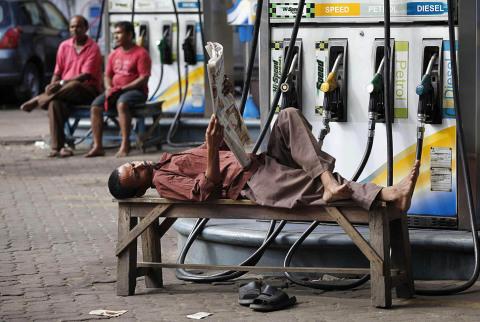GurgaonWorkersNews – Newsletter 46 (January 2012)
Gurgaon in the industrial belt of Delhi is presented as the shining India, a symbol of capitalist success promising a better life for everyone behind the gateway of development. At a first glance the office towers and shopping malls reflect this chimera and even the facades of the garment factories look like three star hotels. Behind the facade, behind the factory walls and in the side streets of the industrial areas thousands of workers keep the rat-race going, producing cars and scooters for the middle-classes which end up in the traffic jam on the new highway between Delhi and Gurgaon. Thousands of young proletarianised middle class people lose time, energy and academic aspirations on night-shifts in call centres, selling loan schemes to working-class people in the US or pre-paid electricity schemes to the poor in the UK. Next door, thousands of rural-migrant workers up-rooted by the rural crisis stitch and sew for export, competing with their angry brothers and sisters in Bangladesh, China or Vietnam. And the rat-race will not stop; on the outskirts of Gurgaon, new industrial zones turn soil into over-capacities. The following newsletter documents some of the developments in and around this miserable boom region. If you want to know more about working and struggling in Gurgaon, if you want more info about or even contribute to this project, please do so via:
http://www.gurgaonworkersnews.wordpress.com
[email protected]
———-
The Different Faces of Crisis – January 2012 Issue
*** I / We in Crisis – A Workers’ Life and Day
On its front-page, Faridabad Majdoor Samachar frequently publishes workers’ stories, relating both to their daily experiences and their life. This is less about ‘story-telling’ and ‘personal accounts’ as such, but about a collective process of discovering not only how the current system shapes our ‘private’ life according to its inner structure, but also how in seemingly ‘individual’ workers’ experiences lies a creative, productive and antagonistic wealth of the working class – the experiences of having worked in rural and urban areas, in various industries, in households and factories; of having gone through the systemic repressive institutions of family and school; of having found ways to survive and undermine the structural pressures. We translated the story of a 37 years old worker.
*** We are the Crisis – Struggles of Teacher Trainees
In most of the recent larger working class mobilisations teachers played a prominent role – from protests against austerity in Spain to the revolt against the regime in Egypt. There are various reasons for this prominent role. There is the obvious trend of proletarianisation of the profession ‘teacher’. The casualisation of ‘semi-skilled’ teaching staff (assistant teachers), the standardisation of work (teaching modules), the austerity measures in the public sector, have eroded the status and conditions of teachers. In many cases teachers become low paid social security guards who are supposed not only to take care of pre-unemployed youth, but also provide them with an illusion of a future. We document the recent struggle of BTC trainees (Basic Training Certificate: basic teaching in primary schools) in Dehradun. The BTC teachers are low paid teachers to teach mainly in poorer areas. They struggled against having to work unpaid for months on so-called ‘practical training’.
*** The Global Crisis Re-Surfaces in India
In autumn 2008 the capitalist strategists still talked about the potential for a ‘decoupling’ of the ’emerging markets’ (China, India, Brazil etc.) from the global crisis. It was clear from the start that the ‘decoupling’ was a myth, a wishful thinking. We summarised some basic figures showing the link: on the impact of the slump 2008, on the national and global bail-out in 2009, on the currency war and state of inflation in 2010, and finally on the Indo-Euro crisis in the second half of 2011.
*** Suggested Reading: Contributions to the Global Overthrow
The global and historical character of the current crisis forces us to coordinate both debate and practice ‘for workers self-emancipation’ on an international scale.
An illustrated book by prole.info, which takes one seemingly simple thing – a house – and examines the social relations around it. From the construction site to the city, from gender roles to trade unions.
The Housing Monster
Blog for the exchange of experiences concerning organising at the workplace.
Re-Composition
*** Delhi Calling: Get Involved in Faridabad Majdoor Talmel
To abolish the global work/war house will take more than informative exercise! If you live in Delhi area, please be welcomed to take part in Faridabad Majdoor Talmel – a workers’ coordination. We distribute around 9,000 copies of Faridabad Majdoor Samachar on ten days each month in various industrial areas around Delhi. You can also participate in the workers’ meeting places which have been opened in various workers’ areas. If you are interested, please get in touch. For more background on Faridabad Majdoor Talmel:
Faridabad Majdoor Talmel

Comments